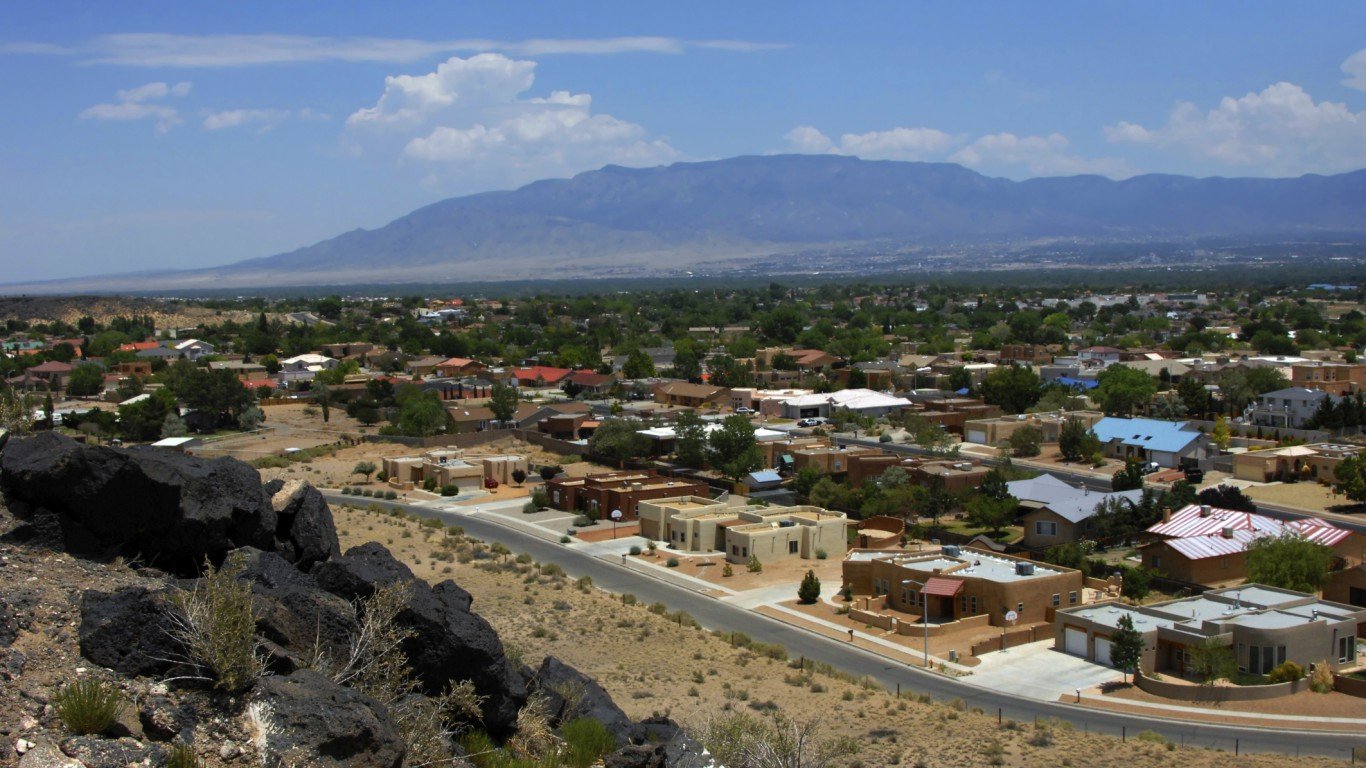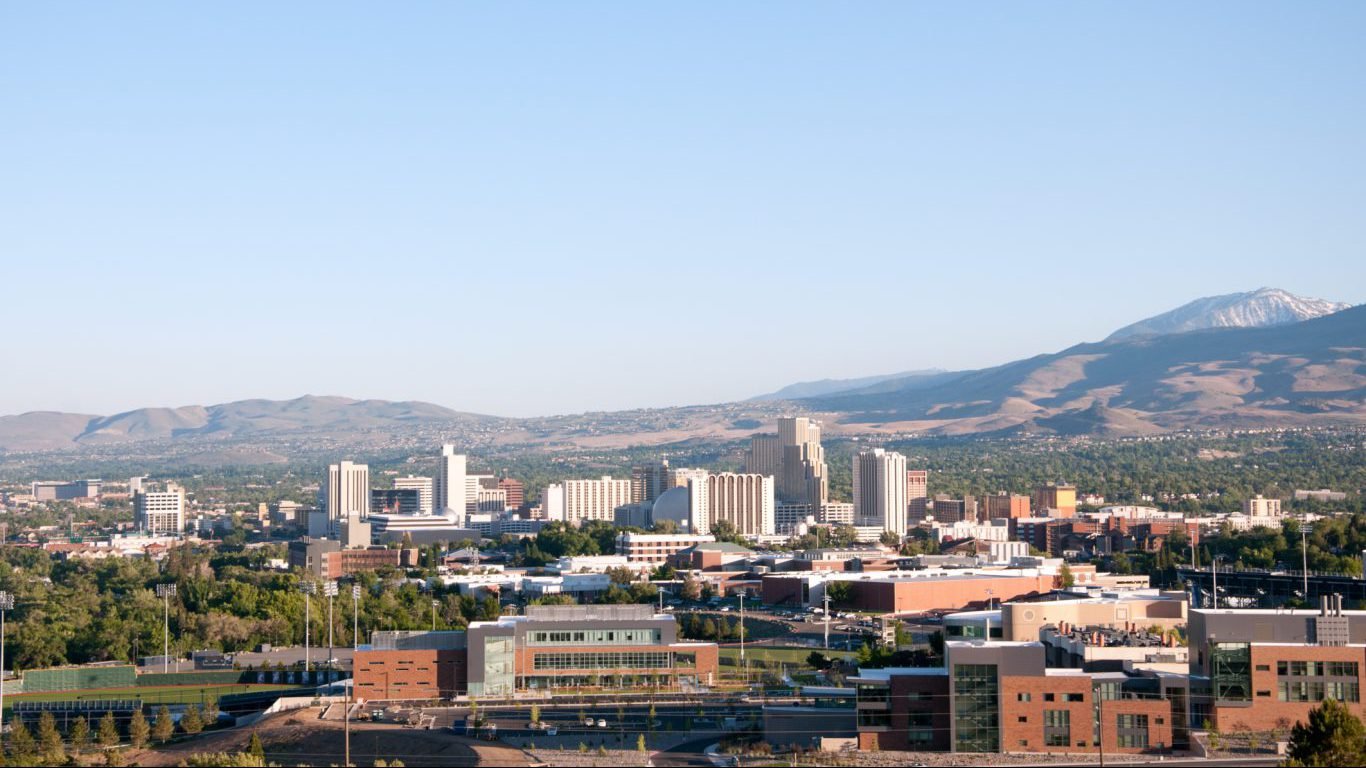Special Report
States Adding (and Losing) the Most Jobs

Published:
Last Updated:

The United States has added more than 12 million jobs since the spring of 2011. Since then, the unemployment rate has fallen from 9.1% to 5.0% — close to an eight-year low.
The vast majority of states have added jobs during April 2011 through April 2016. Most states added at least 100,000 positions. Delaware and Nevada reported a 13% employment growth, and Utah a 14.5% growth, the fastest job growth rates in the country. Despite the generally robust job growth, employment has actually declined in five states. West Virginia lost roughly 11,800 jobs over the last five years, a 1.6% drop.
A state’s labor force — those who are employed or are actively seeking work — tends to grow or decline roughly in parallel with the availability of jobs. Utah and Delaware, the states that added the most jobs, also reported the biggest relative increases in total labor force.
Click here to see the states adding (and losing) the most jobs.
The relationship between the number of jobs and the labor force is not one-to-one. Mississippi’s employment declined by 0.6%, but its labor force shrank by more than 5%, indicating that many people who looked for work have given up and left the labor force. The number of jobs increased by approximately 13% in Nevada over these five years, the third largest increase. On the other hand, the state’s labor force expanded by just 4.4%, the 14th largest growth, likely indicating that many looking for a job found one.
As Nevada’s jobs increased much faster than its labor force did, unemployment improved by 7.1 percentage points, the fastest improvement in the country during that time. In general, states where employment grew the most tended to have the greatest improvements in unemployment, and vice versa.
To identify the states with the most and least job growth, 24/7 Wall St. reviewed states with the most significant changes in employment from April 2011 through April 2016. Unemployment rates, the size of the labor force, and employment levels are from the Current Population Survey (CPS), a monthly survey of households jointly administered by the Bureau of Labor Statistics (BLS) and U.S. Census Bureau. Industry-specific growth rates for the same period are from the Current Employment Survey (CES), also from the BLS.
These are the states where employment is growing fastest, and where it is not growing at all.

50. West Virginia
> Employment decline: -1.6%
> Number of jobs April 2011: 742,153 (13th least)
> Number of jobs April 2016: 730,395 (12th least)
> Unemployment rate April 2016: 6.2% (2nd highest)
> Industry contributing most to decline: Mining and logging

49. Wyoming
> Employment decline: -1.5%
> Number of jobs April 2011: 285,574 (the least)
> Number of jobs April 2016: 281,212 (the least)
> Unemployment rate April 2016: 5.7% (7th highest)
> Industry contributing most to decline: Other services

48. Vermont
> Employment decline: -0.8%
> Number of jobs April 2011: 333,639 (3rd least)
> Number of jobs April 2016: 331,032 (2nd least)
> Unemployment rate April 2016: 3.0% (4th lowest)
> Industry contributing most to decline: Durable goods

47. Mississippi
> Employment decline: -0.6%
> Number of jobs April 2011: 1.21 million (17th least)
> Number of jobs April 2016: 1.20 million (16th least)
> Unemployment rate April 2016: 5.0% (15th highest)
> Industry contributing most to decline: Construction

46. Alaska
> Employment decline: -0.2%
> Number of jobs April 2011: 331,879 (2nd least)
> Number of jobs April 2016: 331,132 (3rd least)
> Unemployment rate April 2016: 6.9% (the highest)
> Industry contributing most to decline: Government

45. New Mexico
> Employment increase: 0.3%
> Number of jobs April 2011: 860,532 (14th least)
> Number of jobs April 2016: 863,168 (14th least)
> Unemployment rate April 2016: 5.8% (5th highest)
> Industry contributing most to increase: Education and health services

44. Kentucky
> Employment increase: 0.4%
> Number of jobs April 2011: 1.86 million (25th least)
> Number of jobs April 2016: 1.87 million (24th least)
> Unemployment rate April 2016: 4.6% (22nd highest)
> Industry contributing most to increase: Professional and business services

43. Maine
> Employment increase: 1.4%
> Number of jobs April 2011: 633,307 (10th least)
> Number of jobs April 2016: 642,291 (9th least)
> Unemployment rate April 2016: 3.8% (15th lowest)
> Industry contributing most to increase: Education and health services

42. Alabama
> Employment increase: 2.2%
> Number of jobs April 2011: 1.99 million (23rd most)
> Number of jobs April 2016: 2.04 million (24th most)
> Unemployment rate April 2016: 5.5% (10th highest)
> Industry contributing most to increase: Manufacturing

41. Connecticut
> Employment increase: 2.3%
> Number of jobs April 2011: 1.73 million (23rd least)
> Number of jobs April 2016: 1.77 million (23rd least)
> Unemployment rate April 2016: 5.6% (8th highest)
> Industry contributing most to increase: Professional and business services

40. Virginia
> Employment increase: 2.9%
> Number of jobs April 2011: 3.94 million (12th most)
> Number of jobs April 2016: 4.05 million (12th most)
> Unemployment rate April 2016: 3.5% (10th lowest)
> Industry contributing most to increase: Education and health services

39. Nebraska
> Employment increase: 3.4%
> Number of jobs April 2011: 958,171 (15th least)
> Number of jobs April 2016: 990,702 (15th least)
> Unemployment rate April 2016: 3.0% (4th lowest)
> Industry contributing most to increase: Professional and business services

38. Kansas
> Employment increase: 3.8%
> Number of jobs April 2011: 1.39 million (20th least)
> Number of jobs April 2016: 1.44 million (20th least)
> Unemployment rate April 2016: 3.4% (8th lowest)
> Industry contributing most to increase: Professional and business services

37. Arkansas
> Employment increase: 4.4%
> Number of jobs April 2011: 1.25 million (19th least)
> Number of jobs April 2016: 1.30 million (17th least)
> Unemployment rate April 2016: 3.4% (8th lowest)
> Industry contributing most to increase: Professional and business services

36. Illinois
> Employment increase: 4.4%
> Number of jobs April 2011: 5.93 million (5th most)
> Number of jobs April 2016: 6.19 million (5th most)
> Unemployment rate April 2016: 6.2% (2nd highest)
> Industry contributing most to increase: Professional and business services

35. Pennsylvania
> Employment increase: 4.4%
> Number of jobs April 2011: 5.88 million (6th most)
> Number of jobs April 2016: 6.14 million (6th most)
> Unemployment rate April 2016: 5.2% (12th highest)
> Industry contributing most to increase: Education and health services

34. Iowa
> Employment increase: 4.5%
> Number of jobs April 2011: 1.57 million (21st least)
> Number of jobs April 2016: 1.64 million (21st least)
> Unemployment rate April 2016: 3.6% (12th lowest)
> Industry contributing most to increase: Construction

33. New Hampshire
> Employment increase: 4.5%
> Number of jobs April 2011: 691,601 (11th least)
> Number of jobs April 2016: 722,703 (11th least)
> Unemployment rate April 2016: 2.6% (2nd lowest)
> Industry contributing most to increase: Professional and business services

32. Ohio
> Employment increase: 4.7%
> Number of jobs April 2011: 5.25 million (7th most)
> Number of jobs April 2016: 5.50 million (7th most)
> Unemployment rate April 2016: 4.8% (20th highest)
> Industry contributing most to increase: Education and health services

31. Rhode Island
> Employment increase: 4.9%
> Number of jobs April 2011: 496,588 (8th least)
> Number of jobs April 2016: 520,750 (8th least)
> Unemployment rate April 2016: 4.9% (18th highest)
> Industry contributing most to increase: Professional and business services

30. New Jersey
> Employment increase: 5.0%
> Number of jobs April 2011: 4.13 million (11th most)
> Number of jobs April 2016: 4.33 million (11th most)
> Unemployment rate April 2016: 4.9% (18th highest)
> Industry contributing most to increase: Education and health services

29. Wisconsin
> Employment increase: 5.4%
> Number of jobs April 2011: 2.81 million (18th most)
> Number of jobs April 2016: 2.97 million (20th most)
> Unemployment rate April 2016: 4.3% (24th lowest)
> Industry contributing most to increase: Education and health services

28. Maryland
> Employment increase: 5.4%
> Number of jobs April 2011: 2.85 million (16th most)
> Number of jobs April 2016: 3.01 million (17th most)
> Unemployment rate April 2016: 4.4% (25th lowest)
> Industry contributing most to increase: Leisure and hospitality

27. New York
> Employment increase: 5.5%
> Number of jobs April 2011: 8.72 million (3rd most)
> Number of jobs April 2016: 9.21 million (4th most)
> Unemployment rate April 2016: 4.6% (22nd highest)
> Industry contributing most to increase: Education and health services

26. South Dakota
> Employment increase: 5.6%
> Number of jobs April 2011: 417,674 (6th least)
> Number of jobs April 2016: 440,856 (5th least)
> Unemployment rate April 2016: 2.6% (2nd lowest)
> Industry contributing most to increase: Education and health services

25. Tennessee
> Employment increase: 5.6%
> Number of jobs April 2011: 2.84 million (17th most)
> Number of jobs April 2016: 3.00 million (19th most)
> Unemployment rate April 2016: 3.9% (18th lowest)
> Industry contributing most to increase: Construction

24. Louisiana
> Employment increase: 5.7%
> Number of jobs April 2011: 1.91 million (25th most)
> Number of jobs April 2016: 2.02 million (25th most)
> Unemployment rate April 2016: 5.8% (5th highest)
> Industry contributing most to increase: Education and health services

23. Oklahoma
> Employment increase: 6.4%
> Number of jobs April 2011: 1.66 million (22nd least)
> Number of jobs April 2016: 1.77 million (22nd least)
> Unemployment rate April 2016: 4.2% (22nd lowest)
> Industry contributing most to increase: Leisure and hospitality

22. Minnesota
> Employment increase: 6.8%
> Number of jobs April 2011: 2.74 million (21st most)
> Number of jobs April 2016: 2.92 million (21st most)
> Unemployment rate April 2016: 3.8% (15th lowest)
> Industry contributing most to increase: Education and health services

21. Hawaii
> Employment increase: 6.9%
> Number of jobs April 2011: 620,891 (9th least)
> Number of jobs April 2016: 663,728 (10th least)
> Unemployment rate April 2016: 3.1% (5th lowest)
> Industry contributing most to increase: Leisure and hospitality

20. Missouri
> Employment increase: 7.5%
> Number of jobs April 2011: 2.79 million (19th most)
> Number of jobs April 2016: 3.00 million (18th most)
> Unemployment rate April 2016: 4.2% (22nd lowest)
> Industry contributing most to increase: Professional and business services

19. Oregon
> Employment increase: 7.6%
> Number of jobs April 2011: 1.79 million (24th least)
> Number of jobs April 2016: 1.93 million (25th least)
> Unemployment rate April 2016: 4.5% (24th highest)
> Industry contributing most to increase: Professional and business services

18. Massachusetts
> Employment increase: 7.7%
> Number of jobs April 2011: 3.19 million (13th most)
> Number of jobs April 2016: 3.44 million (13th most)
> Unemployment rate April 2016: 3.9% (18th lowest)
> Industry contributing most to increase: Education and health services

17. Georgia
> Employment increase: 7.8%
> Number of jobs April 2011: 4.25 million (8th most)
> Number of jobs April 2016: 4.58 million (10th most)
> Unemployment rate April 2016: 5.0% (15th highest)
> Industry contributing most to increase: Professional and business services

16. Montana
> Employment increase: 8.0%
> Number of jobs April 2011: 463,050 (7th least)
> Number of jobs April 2016: 500,199 (7th least)
> Unemployment rate April 2016: 3.9% (18th lowest)
> Industry contributing most to increase: Education and health services

15. North Dakota
> Employment increase: 8.4%
> Number of jobs April 2011: 371,036 (4th least)
> Number of jobs April 2016: 402,134 (4th least)
> Unemployment rate April 2016: 3.2% (6th lowest)
> Industry contributing most to increase: Construction
 Source: Thinkstock
Source: Thinkstock
14. Washington
> Employment increase: 8.9%
> Number of jobs April 2011: 3.13 million (14th most)
> Number of jobs April 2016: 3.41 million (14th most)
> Unemployment rate April 2016: 5.6% (8th highest)
> Industry contributing most to increase: Professional and business services

13. Indiana
> Employment increase: 10.2%
> Number of jobs April 2011: 2.89 million (15th most)
> Number of jobs April 2016: 3.18 million (15th most)
> Unemployment rate April 2016: 4.8% (20th highest)
> Industry contributing most to increase: Manufacturing

12. Texas
> Employment increase: 10.2%
> Number of jobs April 2011: 11.5 million (2nd most)
> Number of jobs April 2016: 12.6 million (2nd most)
> Unemployment rate April 2016: 4.2% (22nd lowest)
> Industry contributing most to increase: Professional and business services

11. Michigan
> Employment increase: 10.5%
> Number of jobs April 2011: 4.16 million (10th most)
> Number of jobs April 2016: 4.60 million (9th most)
> Unemployment rate April 2016: 4.3% (24th lowest)
> Industry contributing most to increase: Manufacturing

10. North Carolina
> Employment increase: 10.7%
> Number of jobs April 2011: 4.16 million (9th most)
> Number of jobs April 2016: 4.61 million (8th most)
> Unemployment rate April 2016: 5.0% (15th highest)
> Industry contributing most to increase: Professional and business services

9. Florida
> Employment increase: 10.8%
> Number of jobs April 2011: 8.35 million (4th most)
> Number of jobs April 2016: 9.26 million (3rd most)
> Unemployment rate April 2016: 4.5% (24th highest)
> Industry contributing most to increase: Professional and business services

8. Arizona
> Employment increase: 10.9%
> Number of jobs April 2011: 2.75 million (20th most)
> Number of jobs April 2016: 3.05 million (16th most)
> Unemployment rate April 2016: 5.4% (11th highest)
> Industry contributing most to increase: Professional and business services

7. California
> Employment increase: 11.2%
> Number of jobs April 2011: 16.2 million (the most)
> Number of jobs April 2016: 18.0 million (the most)
> Unemployment rate April 2016: 5.2% (12th highest)
> Industry contributing most to increase: Professional and business services

6. Colorado
> Employment increase: 11.7%
> Number of jobs April 2011: 2.48 million (22nd most)
> Number of jobs April 2016: 2.77 million (22nd most)
> Unemployment rate April 2016: 3.5% (10th lowest)
> Industry contributing most to increase: Professional and business services

5. Idaho
> Employment increase: 12.1%
> Number of jobs April 2011: 693,782 (12th least)
> Number of jobs April 2016: 777,399 (13th least)
> Unemployment rate April 2016: 3.6% (12th lowest)
> Industry contributing most to increase: Education and health services

4. South Carolina
> Employment increase: 12.1%
> Number of jobs April 2011: 1.95 million (24th most)
> Number of jobs April 2016: 2.18 million (23rd most)
> Unemployment rate April 2016: 5.2% (12th highest)
> Industry contributing most to increase: Professional and business services

3. Nevada
> Employment increase: 13.0%
> Number of jobs April 2011: 1.18 million (16th least)
> Number of jobs April 2016: 1.34 million (18th least)
> Unemployment rate April 2016: 6.1% (4th highest)
> Industry contributing most to increase: Professional and business services

2. Delaware
> Employment increase: 13.0%
> Number of jobs April 2011: 409,226 (5th least)
> Number of jobs April 2016: 462,377 (6th least)
> Unemployment rate April 2016: 4.0% (19th lowest)
> Industry contributing most to increase: Education and health services

1. Utah
> Employment increase: 14.5%
> Number of jobs April 2011: 1.24 million (18th least)
> Number of jobs April 2016: 1.42 million (19th least)
> Unemployment rate April 2016: 3.8% (15th lowest)
> Industry contributing most to increase: Professional and business services
Are you ready for retirement? Planning for retirement can be overwhelming, that’s why it could be a good idea to speak to a fiduciary financial advisor about your goals today.
Start by taking this retirement quiz right here from SmartAsset that will match you with up to 3 financial advisors that serve your area and beyond in 5 minutes. Smart Asset is now matching over 50,000 people a month.
Click here now to get started.
Thank you for reading! Have some feedback for us?
Contact the 24/7 Wall St. editorial team.